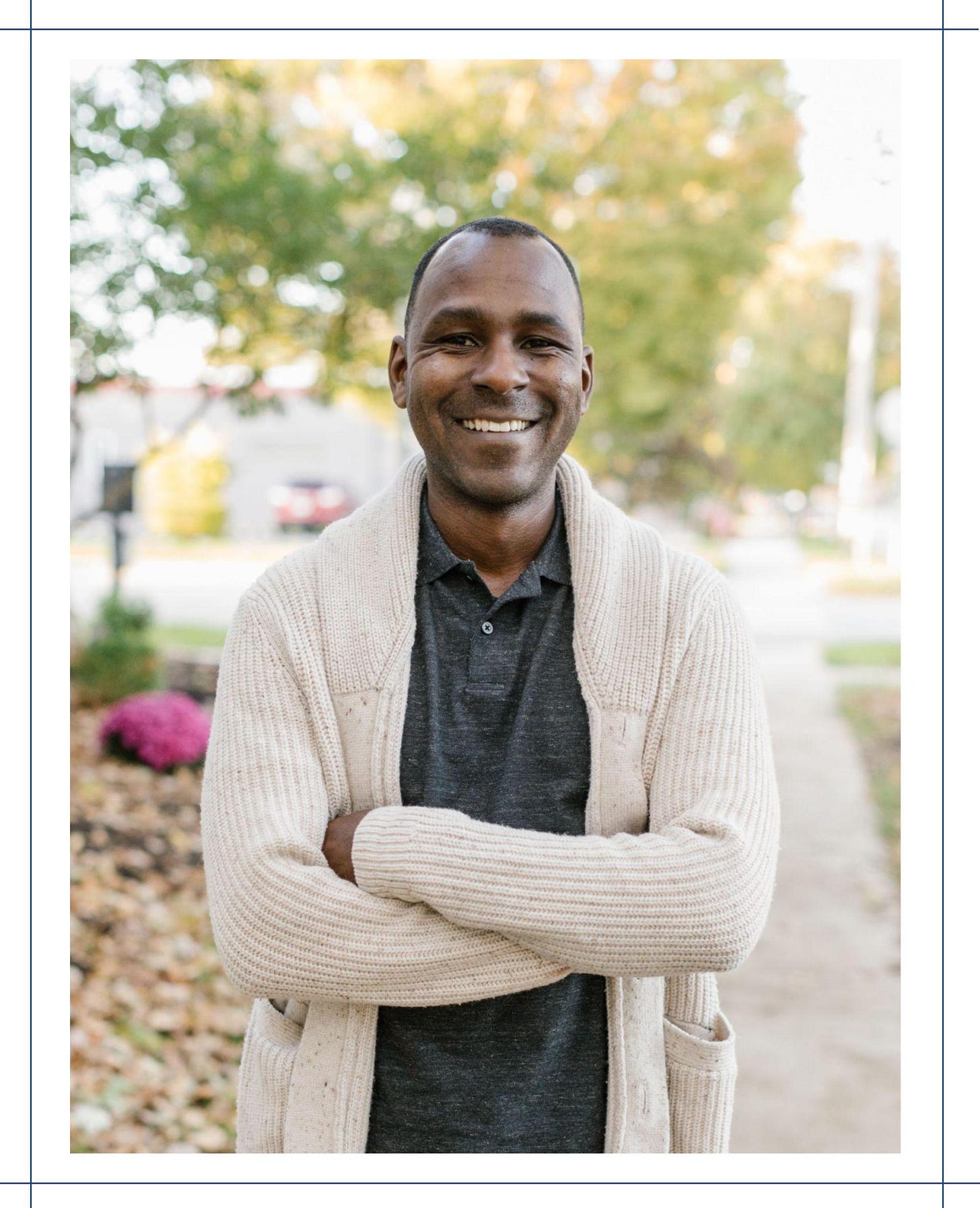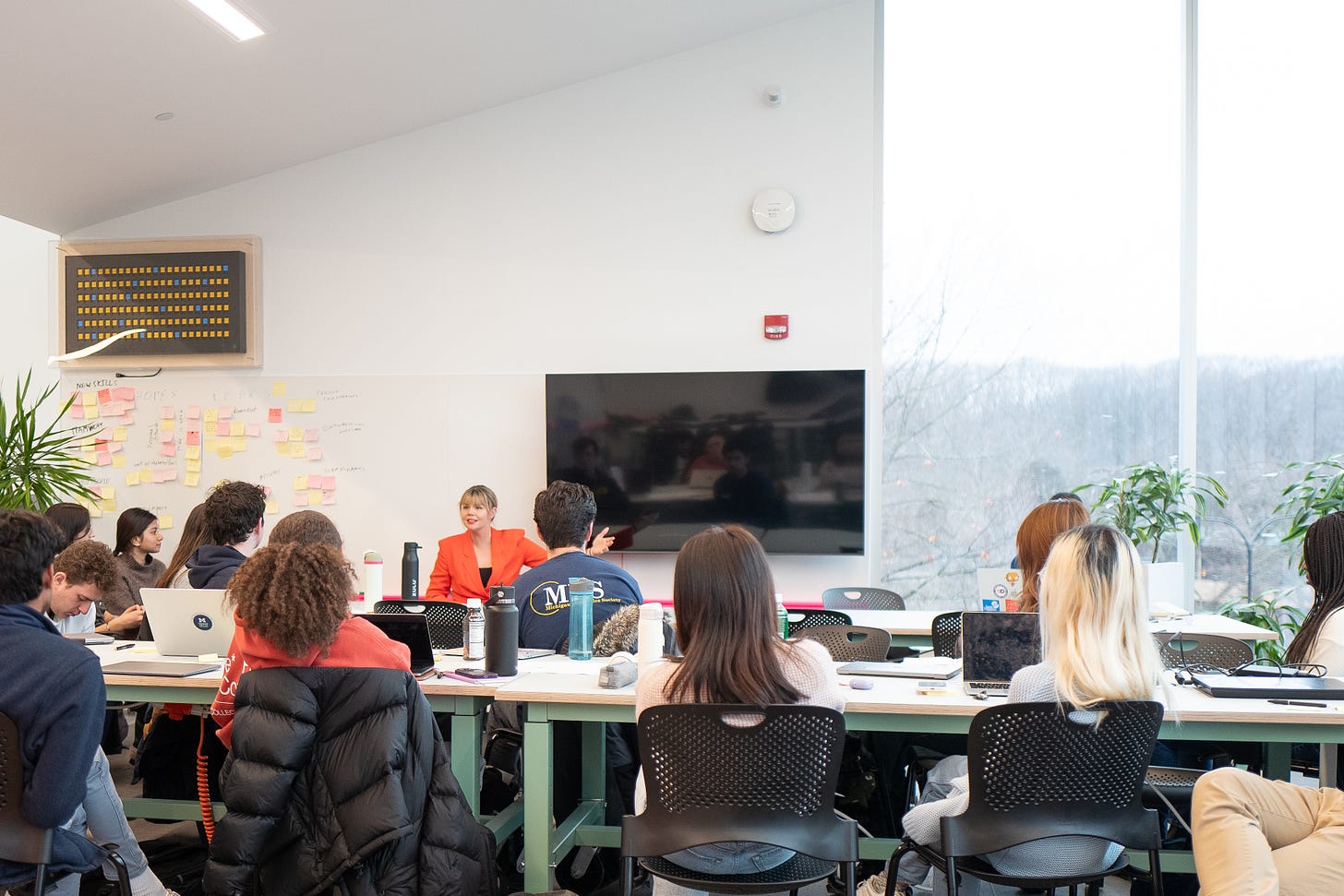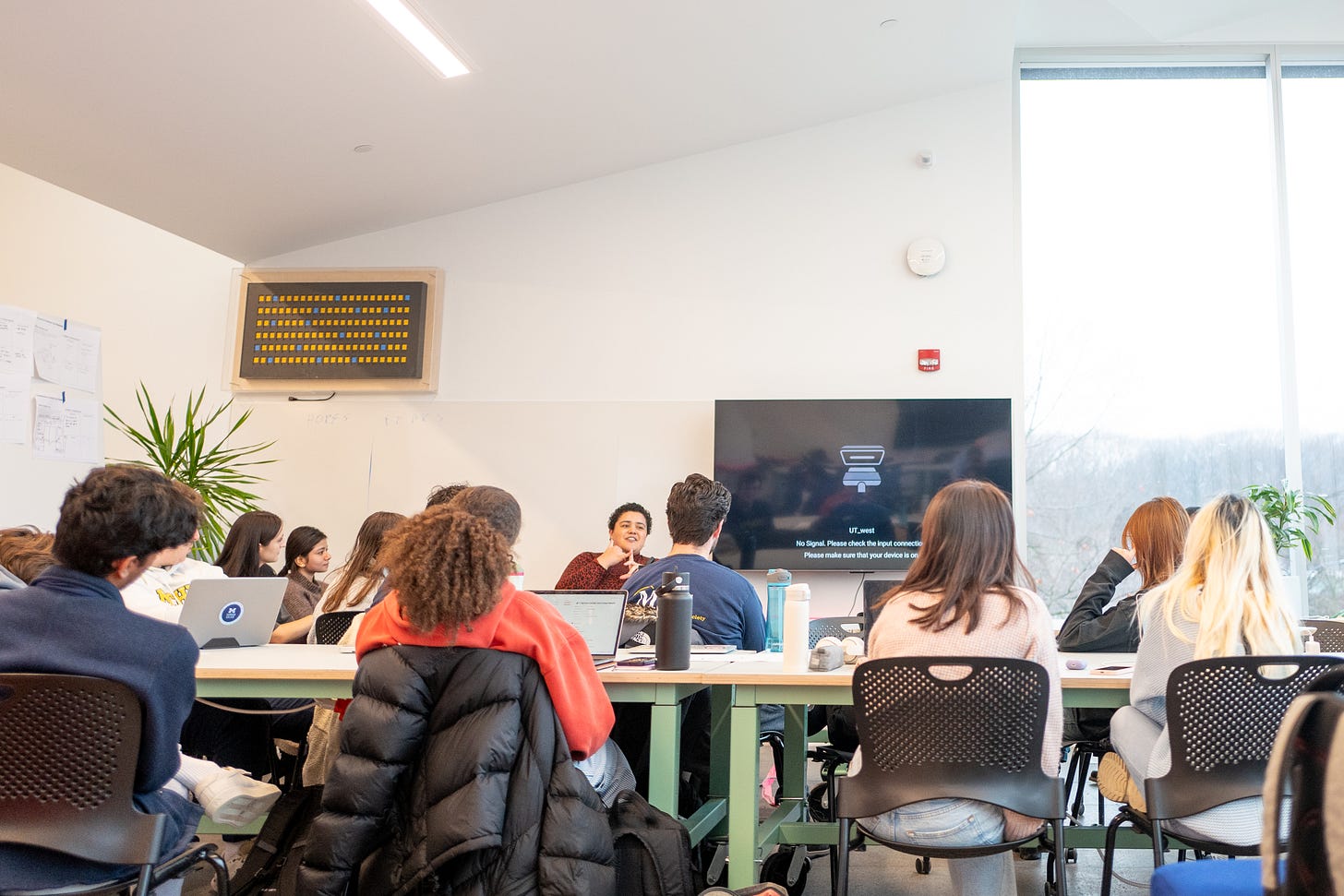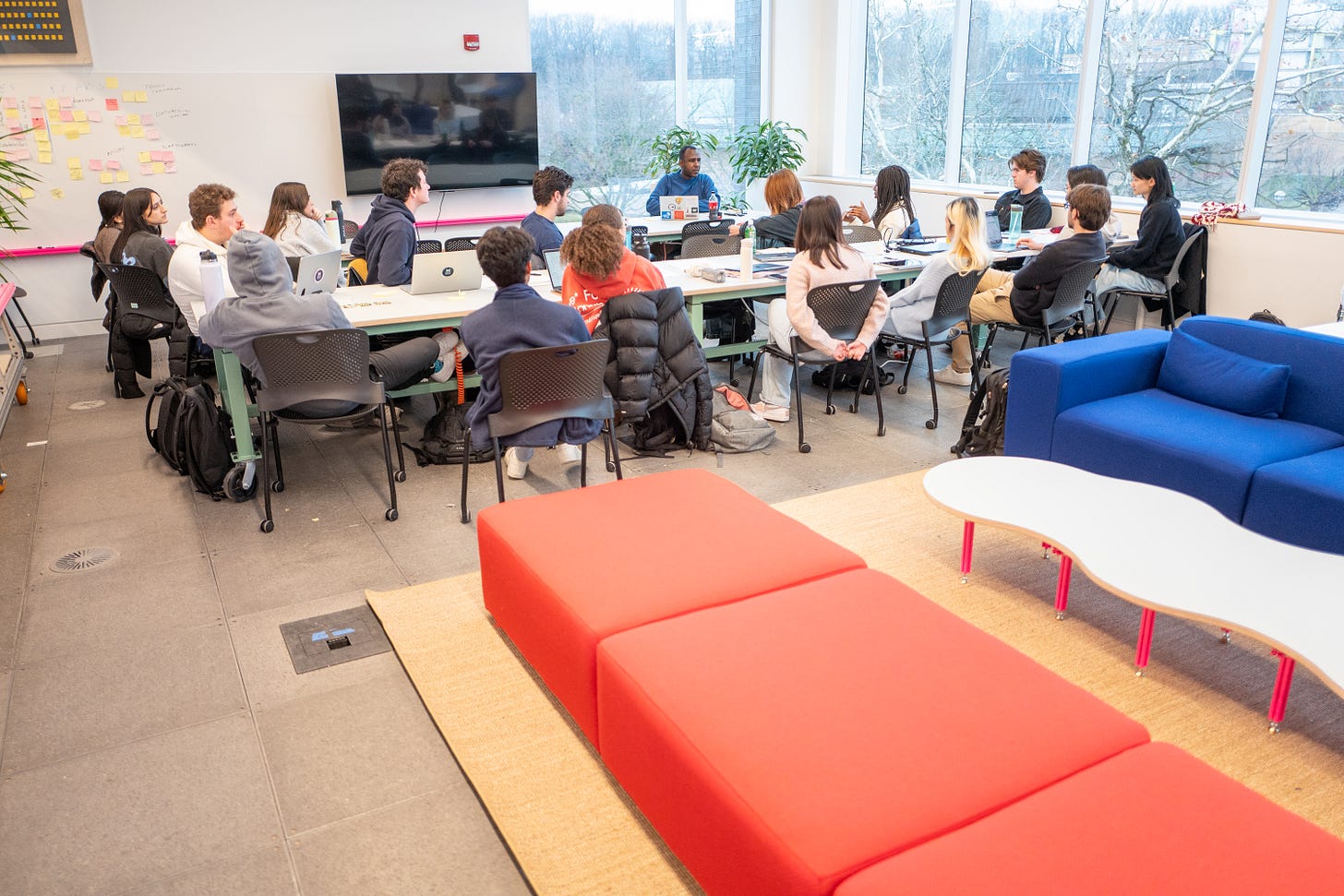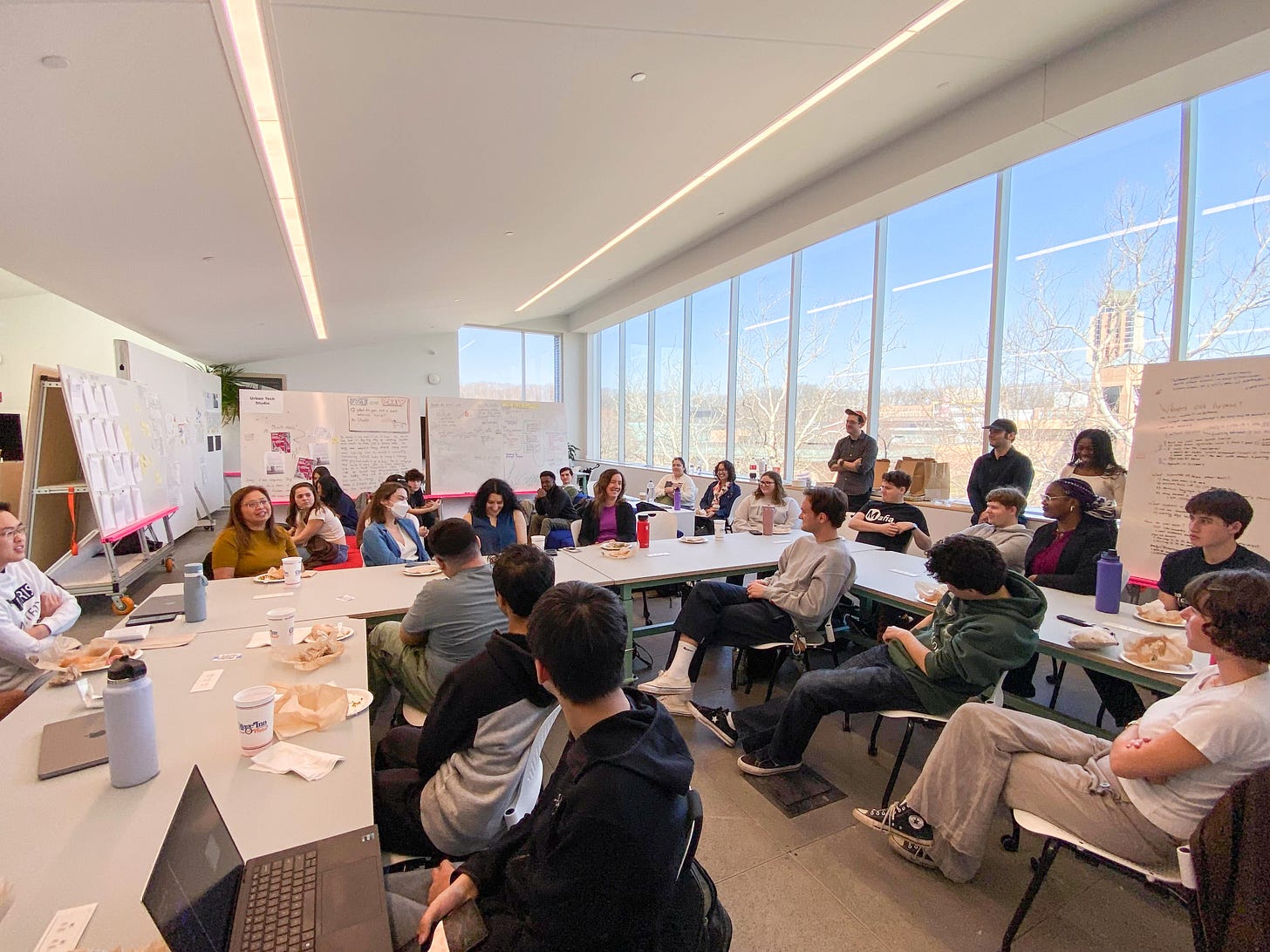Urban Technology at University of Michigan week 190
Thinking about Service Design with Ron Bronson
👋 Charlie and Mariah here, filling in for Bryan while he’s on the road again. Dedicated readers have seen him writing from Saudi Arabia and Oslo, so we’ll have to see where he lands next…
In the meantime, we’re here to revisit a theme from previous issues of this newsletter: service design. Our Urban Technology students take a sequence of four studios, which move from focusing on design methods and inquiry (the first studio), to building their skills in interaction design (the second), to the third studio, which teaches them the methods and practices of service design — the ways we can leverage technology to improve services in cities, on screens and off of them. Our juniors are knee-deep in that course right now, which is being taught by Ron Bronson. Mariah sat down with him to learn more.
💬 Hello! This is the newsletter of the Urban Technology program at University of Michigan, in which we explore the ways that data, connectivity, computation, and automation can be harnessed to nurture and improve urban life. If you’re new here, try this short video of current students describing urban technology in their own words or this 90 second explainer video.
🤝 Service Design with Ron Bronson
Ron Bronson is a designer and information architect who’s currently Director of Design at 18F, a digital services agency in the federal government that just celebrated its 10-year anniversary (the name comes from the General Services Administration’s address in Washington, D.C. - 1800 F Street). Ron thinks long and hard about service design and the ways that technology shapes everyday experiences, which is perfect for us, because this semester he is also teaching our very first service design studio here in Ann Arbor — UT 360: Service Design and Urban Needs. We’re thrilled to have him teaching in the Urban Technology program.
MARIAH EVANS: What does 18F do? And what do you do at 18F?
RON BRONSON: 18F is a federal digital services agency. We work on large scale digital transformation, working to help agencies improve citizen experiences by building better technologies. Sometimes that can be consulting, and sometimes it can be helping them make things.
I'm the Director of Design there, so I oversee a team of around 40 designers who are working on product design, UX design, research, content strategy, and service design.
MARIAH: You mentioned service design, which is still an unknown term for a lot of people. Can you describe it with an example?
RON: My favorite example is a time I was at the airport getting ready to go to Finland. The gate agent walked around the entire terminal asking people, “Zurich, are you going to Zurich? The flight for Zurich is leaving. Are you going to Zurich?” He did that for around 40 people. I was not going to Zurich, but I appreciated the intentionality of what he did, insisting on making sure no one in that immediate area got left behind.
Another good example of service design happened when I was on a plane going to Finland and had a connection at Charles de Gaulle Airport in France. My connection was really tight, and the flight attendant came back to where I was sitting in coach and asked, “Hey, you're going to Helsinki, right?” I said yes, and he said, “You're the only one on the plane going there. I'm going to move you to the front because you're not going to have enough time. You may not make your connection. It's really far.” So he moved me to the front of the plane, and I made my flight because of it. That would never happen here, right? But it totally happened there. It was the coolest thing in the world.
MARIAH: These stories show moments of great care that people were taking to help you on your journey. Is that a good definition of service design?
RON: Improving services [is the work]. Depending on where you are in the world, it can be applied in different ways. In the United States we tend to apply service design to for-profit things [like hotels, airlines, and theme parks]. In the rest of the world, service design really focuses on nonprofits, public space, and improving public services, which is my lens and where I tend to focus.
MARIAH: Why does service design matter for cities? And why should people in cities care about service design?
RON: There are two answers. One, I do not think people in cities should care about service design. I think people should care about good services. What I tell the students is: if we do this right, you won't talk about service design. You won't say “service design.” But you will talk about the good things that are embedded in service design. Folks may not know what service design is, but they do know what it's like to go into an office and have their needs met quickly; or what it’s like to call a number and have a human solve a problem that is outside of the range of normal problems.
To answer the first part, cities are the lowest level of government we have in the United States, so they're the most direct to the public. I worked in local government, and I loved being able to work on digital products there because you would meet people and your friends knew that you were the guy who managed the city website. They would tell people, “Oh, Ron does that. Talk to Ron. He can fix it.” Often it was things that had nothing to do with my purview at all, but I knew who to connect them to.
You don't often get those touchpoints in cities, so I think that that is why people should care about service design in cities.
MARIAH: Service design makes the city more humane?
RON: Yes, people often just need a touchpoint to be able to do the things they want to do in a local area. At its core, especially in larger places, just being able to connect people to the [right person who can help them is helpful].
MARIAH: You’ve written about “consequence design,” which is an evocative term. In terms of consequence design, are the consequences in an urban context somehow different?
RON: Yes, I think that just by the nature of how many people live in cities, there are obviously different consequences. It's this idea that we should be thinking about the ways technology has fundamentally altered the way civic life operates. Much of life is basically the same as it was in the 80s, but now we add a user interface layer to all these experiences. Going to the grocery store often requires a screen, right? Going to the bank today may not require a human, but it used to, and humans are still there, they just can't help you.
My favorite example is the train. You go to the train station and there's a kiosk to buy the ticket. When you go to the front desk to ask for help, the person at the front desk sends you back to the kiosk. Think about how that fundamentally alters the way you live your everyday life in a metropolitan place. No wonder you would hate a city if everything that used to work doesn't work anymore because we decided that you should use a computer to replace any interaction with another person. In the past, we could just solve the problem ourselves in 5 minutes.
So in terms of consequence design, it's thinking of those kinds of things and asking the questions, Do we want to live like this? I guess we're already living this way, so what can we do to mitigate these things? What should we be thinking about? And we need to admonish people at every level of intervention to say, Hey, before you go all the way down the path [to design and build this new thing], let's think about what we're doing, and make sure we're actually serving the people we're trying to serve.
MARIAH: What are students learning in your class? What tools are they adding to their urban technology toolkits?
RON: This is a really interesting semester because we're not only looking at service design, touchpoints, and interactions. Students are also able to look at everyday experiences in a different light because they're seeing every service they encounter as a series of touchpoints, rather than just one experience. They don’t go to Chipotle anymore and just see Chipotle. They see that there's a line at Chipotle, and the reason there’s a line is because there’s only two people working instead of five. So they're able to think more holistically about experiences as emerging designers. Whatever they decide to do after graduation, they can be more intentional about what they're building and how they're thinking about it.
The students are developing all kinds of different skills – not only the ability to look at things more holistically, but also prototyping skills, research skills, and presentation skills. My favorite part of the class is that we are teaching the students how to properly work in a remote environment, so we have a period of the class where we're actually doing that. It's part of the curriculum. That includes different aspects like meetings with me, group meetings, and crits with each other to simulate that environment for the project we're working on. I think that's a fun asset to help them be more prepared for whatever they tackle once they graduate, whether that's grad school, a new job, or something else.
MARIAH: Give us a three sentence preview of what the students are working on in UT 360.
RON: The students are working on projects focused on the State of Michigan's population growth problem. There are three groups that are all working on different aspects of this challenge. Their goal is, in different ways, to invigorate the work that's already being done by our external partner, the Growing Michigan Together Council, to improve Michigan's challenges around population growth and retention. [Editor’s note: We’ll revisit the students’ projects at the end of the semester…]
MARIAH: Final question, and arguably the most important. What is your favorite city and why?
RON: We'll say Helsinki. It's quite small, but I like that it is a little off the beaten path. I like that it is a weird intersection of post-Soviet meets the West. It is also really transit forward, and just marches to the beat of its own drum. I find myself gravitating there quite a bit.
🖼️ Postcard from Ann Arbor
Last week, the Urban Technology Student Org hosted the Digital Benefits Network team from Georgetown’s Beeck Center for Social Impact + Innovation. Thanks to Ariel Kennan (diligent readers will remember her name!), Jennifer Phillips, Elizabeth Bynum Sorrell, Maya Salameh, and Tina Amper for making the trip and spending time with our students.
🏋️ Need an intern for summer 2024? Reply to this email if you’re interested in urban technology students. They have skills in UX design, service design, python, javascript and a zeal for urban challenges.
These weeks: Courses are in full swing, and the energy is high. More admissions. Event planning. A Detroit Trek with UTSO to NewLab. The end of the semester is creeping closer, yielding town halls, faculty share outs, final reviews, and frantic prep for the Cities Intensive.🏃

